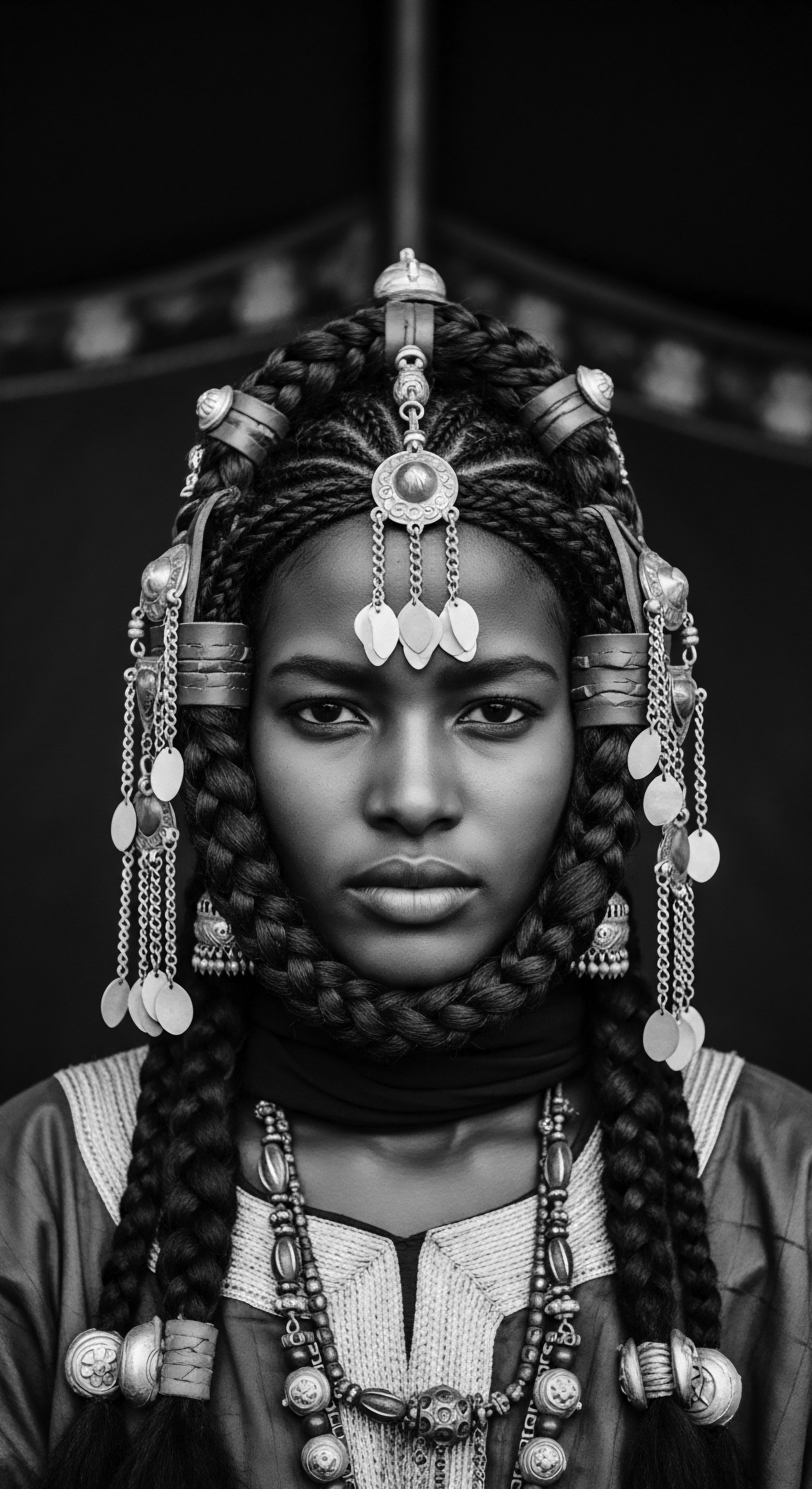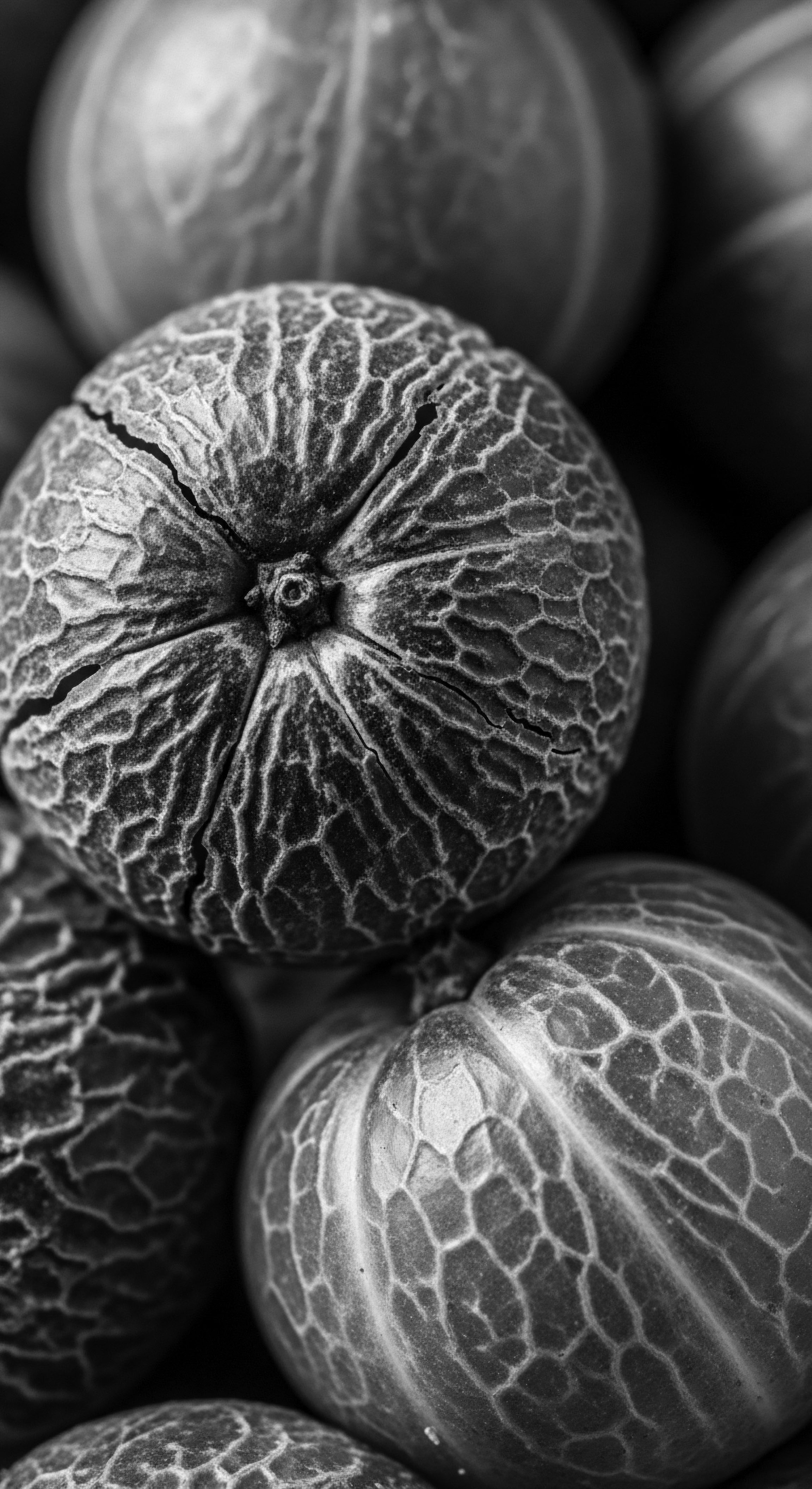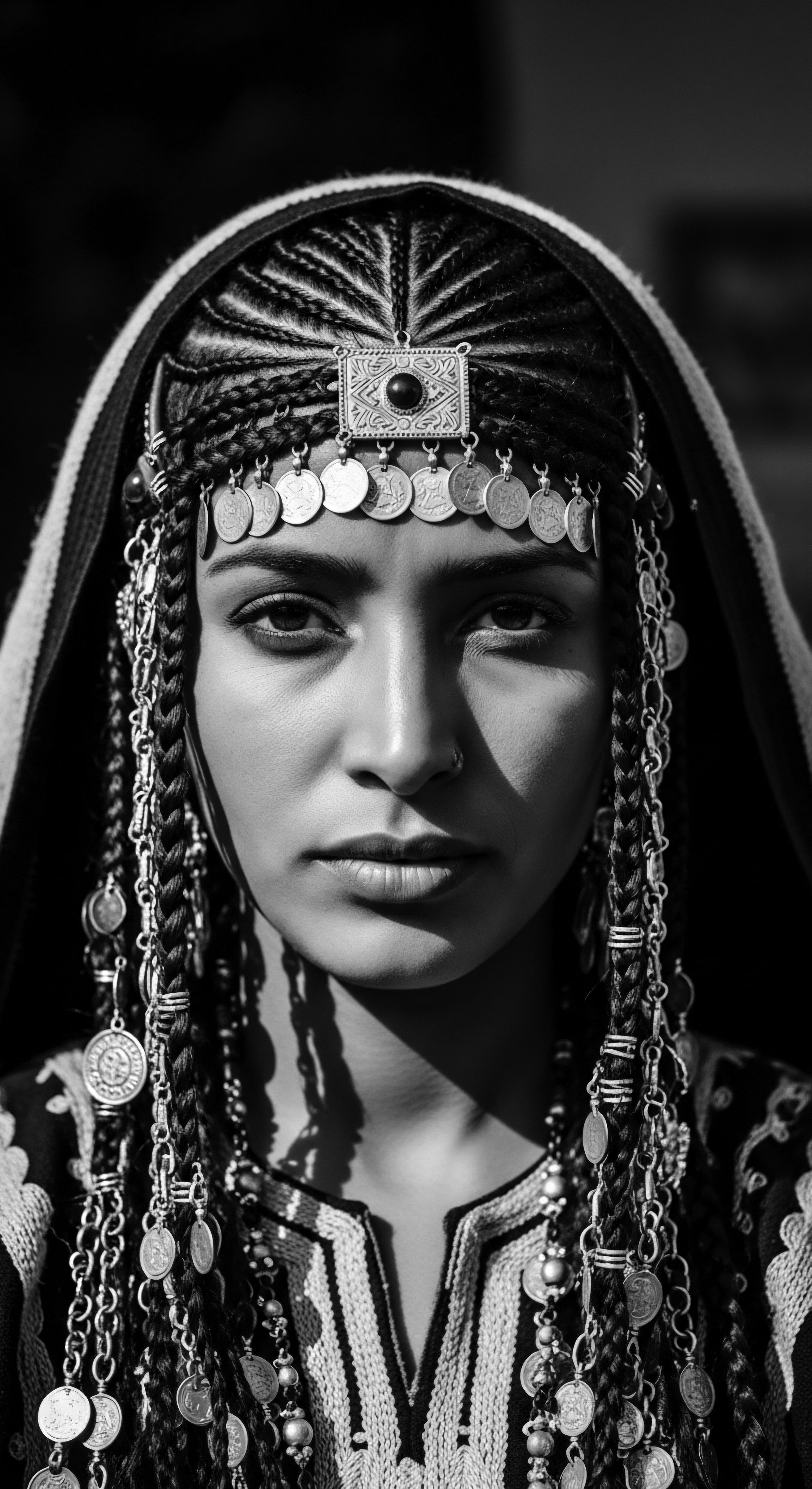
Roots
In every curl, coil, and kink lies a story, an echo of ancestral wisdom stretching back through millennia. For those of us with textured hair, our strands carry more than mere biology; they hold a living history, a direct line to the traditions that shaped civilizations. How did ancient African cleansing rituals shape this heritage? The answer unfolds in the intimate connection between hair, spirit, and community, a bond woven deeply into the very fabric of Black and mixed-race identity.
These practices were not simply about hygiene; they were acts of spiritual alignment, social declaration, and cultural continuity. To truly comprehend this legacy, we must first look at the fundamental nature of textured hair itself, understanding it not just as a biological structure, but as a canvas for ancestral expressions of care.

The Hair’s Intrinsic Design
Textured hair, with its unique follicular structure, presents distinct characteristics that ancient African communities understood with remarkable precision. Unlike straight hair, the elliptical cross-section of textured strands causes them to curl and coil, creating a natural volume and strength that allowed for a multitude of intricate styles. This inherent structural quality meant that cleansing methods had to honor its delicate nature, preventing tangles and preserving moisture. Early African communities recognized that forceful washing could compromise the hair’s integrity, leading to breakage.
Their methods often involved gentle motions and ingredients that detangled and softened rather than stripped. This understanding was not born from scientific instruments but from generations of observation and experiential knowledge passed down through oral traditions.
Cleansing rituals for textured hair in ancient Africa honored its delicate nature, seeking to preserve moisture and prevent breakage.
The variations across textured hair types—from loose waves to tightly wound coils—were not merely aesthetic differences; they often corresponded with specific regional environments, dietary practices, and even social roles. Each hair type demanded a particular approach to care, influencing the choice of natural cleansers and emollients. The way hair grew from the scalp, its natural density, and its propensity for shrinkage were all factors considered in crafting effective, heritage-preserving cleansing practices.

Ancient Cleansing Agents
The materials used in ancient African cleansing rituals were derived directly from the bountiful natural environment. These ingredients were selected not just for their cleansing properties, but also for their nourishing, medicinal, and spiritual qualities. The knowledge of these plant-based cleansers and conditioners formed a foundational element of hair care heritage across the continent.
- African Black Soap (Ose Dudu) ❉ Originating from West Africa, particularly Ghana and Nigeria, this traditional soap was crafted from plantain skins, cocoa pods, palm oil, and shea butter. Its gentle yet effective cleansing ability made it suitable for both skin and hair, removing impurities without stripping natural oils. It offered antibacterial properties for scalp health.
- Rhassoul Clay ❉ Found in the Atlas Mountains of Morocco, this mineral-rich clay was used as a hair and body cleanser. When mixed with water, it formed a paste that absorbed dirt and oil, leaving hair soft and voluminous. Its name, “ghassala,” means “to wash” in Arabic, underscoring its historical purpose.
- Shea Butter (Karité) ❉ While primarily a conditioner and moisturizer, shea butter was often incorporated into cleansing preparations to add slip and prevent dryness. Its properties helped protect hair from environmental elements.
- Plant Extracts ❉ Various leaves, barks, and roots from indigenous plants, often ground into powders or infused in water, provided mild cleansing and conditioning. The specific plants varied by region, reflecting the biodiversity of the continent.

What Did Hair Cleansing Rituals Mean Spiritually?
In many ancient African societies, the head was considered the highest point of the body, a sacred conduit for spiritual energy and communication with ancestors and deities. Cleansing rituals for hair, therefore, transcended mere physical hygiene. They were spiritual acts of purification, preparation, and connection. A clean head and well-tended hair were seen as essential for clear communication with the divine and for receiving blessings.
This belief system elevates the act of washing hair from a mundane task to a profound spiritual observance. Among the Yoruba people, hair was seen as the most elevated part of the body, and braided hair was used to send messages to the gods.
The practice of ritual shaving or cutting hair also carried immense spiritual and social weight. It marked significant life transitions such as birth, coming of age, marriage, or mourning. A baby’s head might be shaved during a naming ceremony to signify their passage from the spirit world to the world of the living, with the shaved hair sometimes used in good luck charms or healing tonics.
Similarly, mourning rituals often involved shaving hair as a sign of respect for the deceased, symbolizing a new phase and a release from the past. This reflects a belief that hair held a person’s life force or spiritual essence.

Ritual
The daily and ceremonial cleansing of hair in ancient Africa was a deliberate, often communal act, steeped in social meaning and traditional practice. These rituals were not isolated moments but were integrated into the rhythms of daily life, community gatherings, and significant life events. They served as vital expressions of communal belonging, individual identity, and a continuum of ancestral care that directly shaped the heritage of textured hair.

The Practice of Hair Cleansing
The methods employed for hair cleansing were highly refined, passed down through generations. Rather than harsh scrubbing, the focus was on gentle manipulation, finger-detangling, and the slow working of natural cleansing agents through the strands. This approach preserved the hair’s natural oils and minimized breakage, which is particularly important for coiled textures prone to dryness.
The process often began with the application of water, sometimes infused with herbs, followed by a mild saponifier like African black soap or a clay paste. Rinsing involved soft streams of water, often from natural sources, ensuring thorough removal of impurities without stripping the hair.
For example, in certain West African societies, the washing of hair could be a collective activity, fostering social bonds and shared knowledge. Women would gather, often under a tree, to tend to each other’s hair, sharing stories, wisdom, and techniques. This communal grooming reinforced familial connections and community ties, turning a routine act into a cherished social event.

How Did Cleansing Rituals Mark Social Status?
Hair, cleansed and styled, served as a powerful visual communicator of one’s identity within ancient African societies. The cleanliness of one’s hair, its style, and its adornments could signify a person’s age, marital status, wealth, ethnic affiliation, or even their spiritual role within the community. The very act of a thorough cleansing ritual, followed by meticulous styling, was a demonstration of self-care and social standing, indicating that an individual possessed the resources, time, and community support to maintain their presentation. An unkempt appearance, conversely, could signify illness, mourning, or social distress.
Different ethnic groups developed distinct cleansing routines and subsequent styling practices that identified their members. For instance, the Himba people of Namibia traditionally use a red ochre paste mixed with butterfat (otjize) to coat their hair and skin. This practice, while not a traditional “cleansing” in the Western sense, is a central part of their beauty and cultural practices, requiring a specific preparation that keeps the hair protected and moisturized, linking hygiene to a broader aesthetic and social declaration. The careful application of otjize follows its own form of preparation and maintenance, which for them, embodies their heritage and social standing.
| Ingredient Name African Black Soap |
| Traditional Source Region West Africa (Ghana, Nigeria) |
| Benefits for Textured Hair Deep cleansing, removes buildup, soothes scalp irritation, anti-fungal properties. |
| Ingredient Name Rhassoul Clay |
| Traditional Source Region North Africa (Morocco) |
| Benefits for Textured Hair Gentle cleanser, absorbs excess oil, adds volume, improves elasticity. |
| Ingredient Name Qasil Powder |
| Traditional Source Region Horn of Africa (Somalia, Ethiopia) |
| Benefits for Textured Hair Cleansing, scalp health, adds shine, strengthens strands. |
| Ingredient Name Shea Butter |
| Traditional Source Region West and East Africa (Sahel region) |
| Benefits for Textured Hair Moisture retention, sealant, soothes scalp, protects from environmental elements. |
| Ingredient Name These natural elements formed the basis of hair care, adapted to specific regional resources and passed down through generations. |

Cleansing in Rites of Passage
Cleansing rituals often marked significant transitions in an individual’s life, serving as powerful ceremonial moments. From birth to adulthood, marriage, and even death, hair cleansing was often a preparatory act, symbolizing purification and readiness for a new phase. These rites reinforced the communal aspect of identity, where individual changes were acknowledged and supported by the collective.
The ceremonial washing of young women’s hair in coming-of-age ceremonies, for instance, prepared them for new responsibilities and roles within the community. It signified a purification from childhood and a readiness to embrace the duties of womanhood. This practice reinforced communal values and provided guidance through life’s transformations. The continuity of these practices, even in modified forms, helps shape the heritage of textured hair, linking contemporary care to ancient rites.
Hair cleansing rituals served as vital expressions of communal belonging and individual identity, profoundly shaping textured hair heritage.
The act of grooming and cleansing was more than mere aesthetics. It was a language spoken through touch, scent, and visual artistry. The scent of natural oils, the feel of soft hands working through coils, the rhythmic sound of braiding—all contributed to a sensory experience that reinforced cultural belonging and ancestral wisdom. These sensory memories, inherited through generations, contribute to the deep emotional connection many feel to their textured hair and its care.

Relay
The ancestral knowledge embedded in ancient African cleansing rituals has traveled across continents and generations, informing and shaping the contemporary understanding of textured hair heritage. This relay of wisdom, from elemental biology to living tradition, reveals a profound, interconnected understanding of care that transcends simple surface-level hygiene. It is a testament to the ingenuity of early African communities and the resilience of their practices.

What Ancient Cleansing Rituals Shaped Contemporary Practices?
The principles underlying ancient African cleansing rituals—gentleness, moisture retention, and the use of natural ingredients—continue to influence modern textured hair care. Early African “shampoos” were often multi-purpose bars or preparations of natural oils, butters, powders, and resins designed for growth, strength, and curl enhancement. This contrasts sharply with later Westernized concepts of harsh, stripping detergents.
Consider the widespread popularity of African Black Soap in contemporary natural hair circles. This traditional cleanser, often handmade from plantain skins and cocoa pods, is sought after for its ability to deep clean without stripping the hair of its essential moisture. Its resurgence mirrors a desire to reconnect with ancestral methods validated by modern understanding of hair science. Similarly, the use of shea butter, a staple in many ancient cleansing and conditioning routines, remains a cornerstone of textured hair regimens today, prized for its sealing and moisturizing properties.
The philosophical approach to hair care also resonates. Ancient practices viewed hair care as a holistic activity, connected to overall well-being and spiritual balance. This outlook is mirrored in the contemporary natural hair movement’s emphasis on wellness, mindful routines, and self-acceptance. The “crown” identity, which views hair as a sacred adornment, is a direct echo of pre-colonial African beliefs where the head was revered as the closest point to the divine.

Ancestral Cleansing and Identity Preservation
The transatlantic slave trade presented a brutal rupture in the continuity of these practices. Enslaved Africans were often stripped of their traditional tools, ingredients, and the very time needed for elaborate hair care. Their heads were frequently shaved as a dehumanizing act, an attempt to erase their cultural identity and ancestral connection.
Despite this deliberate erasure, the heritage of textured hair cleansing and styling endured through resistance and adaptation. Enslaved people found ways to improvise, using what was available—cooking oil, animal fats, and butter—to care for their hair, even if these substitutions were not ideal.
This period underscores the remarkable resilience of African cleansing heritage. The knowledge, though disrupted, was not lost entirely. It was whispered, taught in secret, and adapted, becoming a quiet act of defiance and a powerful way to preserve a sense of self and connection to an ancestral past.
The very act of maintaining one’s hair, however crudely, became a symbol of enduring identity against oppressive forces. This tenacity highlights why textured hair heritage is so intertwined with themes of survival and self-determination.
The enduring legacy of African hair cleansing practices reflects a profound resilience, demonstrating how ancient wisdom adapted and persisted through immense historical challenges.

A Case for Yoruba Spiritual Cleansing and Hair
To illustrate the powerful continuity of ancient cleansing rituals shaping heritage, consider the Yoruba people of West Africa. Hair in Yoruba cosmology holds profound spiritual significance, understood as a channel for spiritual energy and a connection to ancestors and deities (Omotoso, 2018). Cleansing rituals were, and continue to be, intertwined with these spiritual beliefs. For example, during certain rites of passage, such as naming ceremonies for infants (seven or nine days after birth), a baby’s head may be shaved.
This act marks the passage from the spirit world into the world of the living, symbolizing a spiritual cleansing and a formal entry into the community (Byrd and Tharps, 2014, p. 11). The shaved hair, seen as carrying spiritual essence, might then be used in protective charms or healing tonics.
Adult cleansing practices among the Yoruba also reflect this spiritual dimension. The concept of Ọ̀túnwá, or realignment, involves daily rituals to maintain balance and connection with divine forces. Spiritual cleansing baths, often incorporating sacred herbs like Osùn (camwood) or ‘Hierba Buena’ (often used for digestive issues but also in spiritual cleansing), are prescribed to remove negative energy or ‘ibi’ (negativity) from one’s ‘Ori’ (inner divine self or locus of personal destiny). These baths are not merely for the body; they are for the spirit, preparing the individual for spiritual alignment and good fortune.
The hair, as the highest point of the body and a spiritual gateway, is implicitly or explicitly cleansed as part of this process, ensuring clear reception of blessings. This historical and ongoing practice demonstrates a direct line from ancient spiritual beliefs about cleansing to the heritage of hair care as an act of holistic well-being and alignment with destiny.
This practice is not anecdotal; scholars like Omotoso (2018) and Byrd and Tharps (2014) extensively discuss the intrinsic link between hair and spiritual identity among the Yoruba, with cleansing practices serving as tangible expressions of these beliefs. The enduring presence of these rituals, even in diaspora communities, shows a consistent heritage, proving the depth of the connection between ancient practices and modern identity.
- Early Morning Rituals ❉ Many traditional cleansing rituals began at dawn, often with cool water, symbolizing new beginnings and purification before the day’s tasks.
- Herbal Infusions ❉ Water used for cleansing was frequently infused with leaves, barks, or roots known for their purifying or conditioning properties, creating a natural hair tonic.
- Detangling with Care ❉ The act of detangling was performed with fingers or wide-toothed tools, always with patience and gentleness, to preserve the hair’s natural curl pattern and length.
- Communal Cleansing Spaces ❉ Hair care was often a shared activity, fostering social bonds and transmitting generational knowledge of techniques and recipes.

Reflection
The whispers of ancestral hands, the scents of earth-borne cleansers, and the rhythms of ancient rituals echo within every strand of textured hair today. Understanding how these profound African cleansing rituals shaped our heritage invites us to stand in a deeper reverence for our crowns. The journey from elemental biology to complex cultural expression, from ancient practices to enduring legacies, reminds us that textured hair is far more than a physical attribute; it is a living archive, a testament to resilience, beauty, and unwavering spirit.
Roothea’s commitment to the ‘Soul of a Strand’ ethos finds its true grounding in this ancestral wisdom. Our connection to textured hair is a continuous conversation with those who came before us, a dialogue carried through the science of its structure, the artistry of its care, and the deep cultural significance it holds. Each cleansing, each conditioning, each deliberate act of tending to our hair becomes a reaffirmation of this profound heritage, a quiet act of honoring the lineage we carry.
We find strength in the knowledge that our practices today are not isolated, but are part of a continuous, luminous thread stretching back through time, binding us to the ingenuity and spirit of our ancestors. To understand this history is to claim the full power of our textured selves, recognizing our hair as a vibrant declaration of who we are and from whom we come.

References
- Omotoso, Sharon Adetutu. “Gender and Hair Politics ❉ An African Philosophical Analysis.” Journal of Pan African Studies, vol. 11, no. 1, 2018.
- Byrd, Ayana, and Lori Tharps. Hair Story ❉ Untangling the Roots of Black Hair in America. St. Martin’s Press, 2014.
- Kouame, G. D. “African Hair Care and the Transmission of Indigenous Knowledge.” African Studies Review, 2021.
- Mbiti, John S. African Religions and Philosophy. Heinemann, 1969.
- Falola, Toyin. Yoruba Warlords of the Nineteenth Century. Africa World Press, 2001.
- Asare, Edward. “The Role of Hair in Ancient African Cultures.” EdwardAsare.com, 2021.
